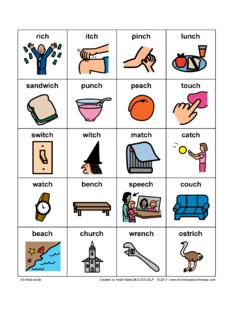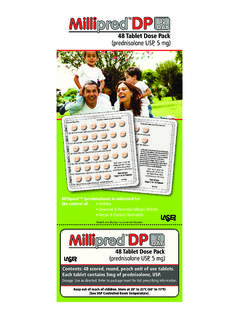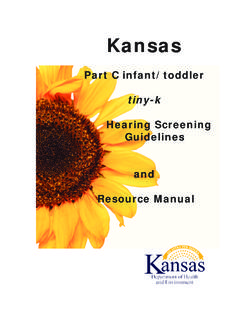Transcription of Field and greenhouse evaluation of rapeseed spray oil ...
1 Bulletin of Insectology 62 (2): 159-167, 2009. ISSN 1721-8861. Field and greenhouse evaluation of rapeseed spray oil against spider mites, green peach aphid and pear psylla in Serbia Dejan MAR I , Pantelija PERI , Mirjana PRIJOVI , Irena OGURLI . Institute of Pesticides and Environmental Protection, Laboratory of Applied Entomology, Belgrade, Serbia Abstract Biological efficacy of rapeseed spray oil against twospotted spider mite (Tetranychus urticae Koch) on cucumber, against Euro- pean red mite [Panonychus ulmi (Koch)] on apple, green peach aphid (Myzus persicae Sulzer) on pepper and pear psylla [Cacop- sylla pyri (L.)]
2 ] was evaluated in seven Field and three greenhouse trials at eight localities in Serbia during 2005-2008. The efficacy of rapeseed spray oil in controlling these pests was compared to the following insecticides and/or acaricides: abamectin, acetami- prid, bifenthrin, clofentezine, diflubenzuron, dimethoate, fenazaquin, mineral oil, combination of mineral oil and methidathion, pymetrozine and spirodiclofen. In two greenhouse trials against a T. urticae population on cucumber, the efficacy of rapeseed oil was and , 11 days after treatment (DAT). Applied as a late dormant oil against winter eggs of P. ulmi in two apple orchards at the BBCH 09 growth stage, rapeseed spray oil achieved and efficacy, 24 DAT.
3 In a treatment against the summer population of P. ulmi, rapeseed oil showed (7 DAT), (14 DAT), (21 DAT) and (38 DAT). efficacy. Three Field trials against M. persicae on pepper revealed high (> 96%, 7-14 DAT) efficacy of rapeseed spray oil; in a greenhouse trial, the oil achieved efficacy 8 DAT. Applied at the BBCH 09 pear growth stage against eggs laid by winter- form females of C. pyri, rapeseed oil showed a total efficacy of > 90% in both assessments. Such high and persistant efficacy pri- marily results from the fact that the number of newly deposited, white eggs was reduced to null, while the effect on nymphs was weaker.
4 The importance of these results for biorational pest control of spider mites, green peach aphid and pear psyllid in Serbia is discussed. Key words: rapeseed spray oil, twospotted spider mite, European red mite, green peach aphid, pear psylla, pest control. Introduction caused by their extended, frequent and unrational use, many arthropod pest populations, including spider mi- Fruit and vegetable production in Serbia is generally tes, aphids and psyllids, have developed resistance wor- threatened by a number of arthropod pests, including ldwide (Pree et al., 1990; Bu s et al., 1999; Schaub et prominently the spider mites (Acari Tetranychidae) and al.)
5 , 2001; Foster et al., 2007; Whalon et al., 2008). In aphids (Homoptera Aphididae). Two-spotted spider Serbia, there have been reports of resistance incidence mite (Tetranychus urticae Koch), a highly polyphagous in some populations of these pests (Mar i , 1997; Vu e- and cosmopolitan species, is a common pest of green- ti et al., 2007; 2008), and of reduced Field efficacy of house crops, while European red mite [Panonychus ulmi pesticides in controlling the species at various sites (Koch)] occurs regularly in orchards heavily sprayed (Mar i et al., 1998; 2007a; 2007b). Besides resistance with pesticides (Stojni and Petanovi , 1997; Zhang, evolution, most conventional pesticides are harmful to 2003).
6 Green peach aphid (Myzus persicae Sulzer) is a arthropod natural enemies and other non-target species. cosmopolitan and polyphagous species, highly efficient This situation has created a need to develop and intro- as a virus vector (Blackman and Eastop, 2007). Its sec- duce biorational pesticides synthetic and/or natural ondary (summer) hosts in Serbia include pepper, to- compounds with novel modes of action that are more bacco, tomato, cabbage and over 30 other plant species selective and ecotoxicologically safer, and therefore (Petrovi , 2003). Pear psylla, Cacopsylla pyri (L.) suitable to be included in pest management programs (Hemiptera Psyllidae), is the most important pest in based on integration of biological and chemical control pear-growing regions of Europe.
7 In Serbia, overwinter- measures (Horowitz and Ishaaya, 2004). ing females begin to lay eggs as early as in mid- Besides neonicotinoids, insect growth regulators, February and the first generation nymphs appear before compounds derived from soil microorganisms and other flowering in the first half of April, causing feeding novel groups of insecticides and acaricides, horticultural damage on young leaves and buds. Apart from the im- spray oils (mineral and vegetable) may also be consid- mediate damage, the pest is also a vector of pear decline ered as biorational pesticides. Horticultural oils have a phytoplasma.
8 Successful early season control of this number of advantages over conventional insecticides: pest is necessary to forestall problems during the fol- they are less disruptive to natural enemies and non-toxic lowing growing season (Stamenkovi et al., 1993; to vertebrates, they break down easily in the environ- Carraro, 1998; Horton, 1999; Duduk et al., 2008). ment and are generally much safer to use from an eco- Several compounds commonly referred to as conven- logical and human health perspective (Davidson et al., tional insecticides (organo-phosphates, carbamates, py- 1991; Agnello et al., 1994; Nicetic et al.))
9 , 2001; Martin- rethroids), as well as a few acaricides, have been widely L pez et al., 2006). Environmental toxicity of vegetable used to control these and other harmful insects and mi- oils is even lower than that of mineral oils and they are tes. However, as a result of heavy selection pressures, compatible with organic farming (Zehnder et al., 2007). Moreover, phytotoxicity risks are lower with vegetable oils than they are with mineral oils. Among biorational pesticides, horticultural spray oils have another advan- tage: their mode of action on insects and mites is usually assumed to be suffocation, so that development of resis- tance is not likely to happen (Davidson et al.
10 , 1991; Ag- nello et al., 1994; Jaastad, 2007). Mineral oils have been used against a wide spectrum of arthropod pests (Davidson et al., 1991; Lawson and Weires, 1991; Agnello et al., 1994; Nicetic et al., 2001;. Agnello, 2002; Fernandez et al., 2005; Martin-L pez et al., 2006; Jaastad, 2007), while our current knowledge of the effects of vegetable oils as insecticides and/or a- caricides is more limited. The aim of this study was to investigate Field and greenhouse efficacy of rapeseed spray oil - an emulsifiable concentrate of refined oil de- rived from Brassica napus L. seeds - against spider mites, green peach aphid and pear psylla in Serbia.










